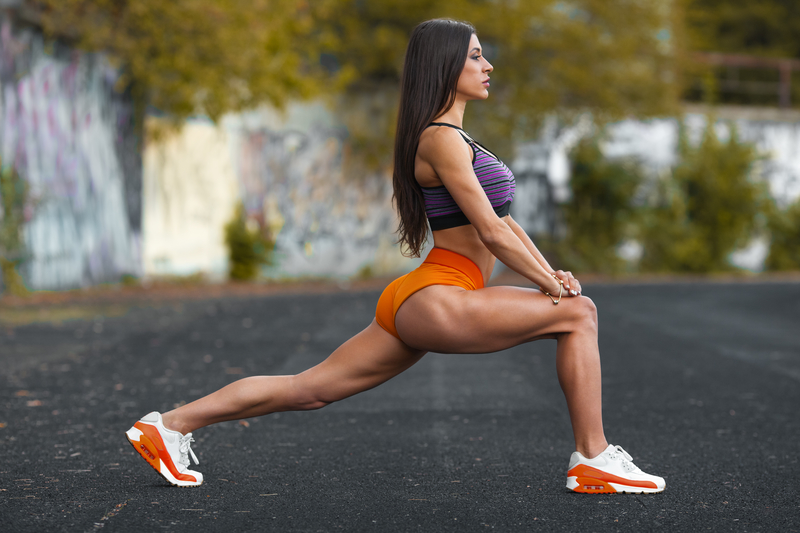Build a Strong Foundation with this Powerful Leg Day Workout

Having a strong foundation is important. Your legs support your body and help you perform many movements throughout each day. Building and strengthening your foundation should be a pivotal part of your workout program. Here’s how to build that strong base with this powerful leg day workout.
What Are Your Foundation Leg Muscles
Your legs are comprised of several muscle groups and need to be exercised accordingly. The most well-known muscles are the hamstrings (upper back of your legs), the quadriceps (the upper front of your legs), and your calf muscles (on the backs and sides of the lower legs). You could also include the butt (gluteus muscles), technically speaking, because the glutes also get worked during leg exercises and are generally a focus when training legs.
Each region of the leg has its own group of muscles as well:
Quadriceps:
- Vastus lateralis
- Vastus medialis
- Vastus intermedius
- Rectus femoris
Hamstrings:
- Biceps femoris
- Semimembranosus
- Semitendinosus
Calves:
- Gastrocnemius
- Soleus
- Plantaris
What Are the Benefits of a Powerful Leg Day Workout?
Besides the obvious benefits of having a nice set of wheels (and glutes), there are numerous other perks to focusing on a leg day workout and a strong foundation:
- Overall strengthening of your entire body, including the core and upper body
- Increased functional strength
- Increased burning of body fat
- Lubricate your joints
- Strengthening joints
- Releasing growth hormone
- Building muscle
- Raising your metabolism
- Improving health
- Improved symmetry
- Building mental strength
- Improved athletic performance
Our Favorite Leg Day Workout to Build a Strong Foundation
Always remember to warm up thoroughly. The best leg day workout warmup will be something that gets your blood circulating and really warms up all the muscles, joints, and ligaments in the legs. A few good warmups you can use are:
- Walking
- A gentle jog
- Incline treadmill walk
And, once you’re thoroughly warmed up, it’s time to get into your leg day workout. While exercises you can use to work your legs are nearly endless, try to pick exercises that will work all three areas of your legs (upper front, back, and calves) during the course of your workout. It is important to note that all the muscles in your legs will be worked to some degree, regardless of your focus area, but to develop symmetry and balance, try to do exercises that cover all the bases. Here are a couple foundational exercises to help you build that strong base you need.

1. Squats
This compound exercise works your whole lower body and is a staple in most leg workout programs. There are many ways you can place your feet to emphasize various areas of the legs as well as numerous styles of squats you can try.
Begin with a body-weight squat. Place your hands either behind your head or on your hips. With your legs and hips squared and feet hips-width apart, with your toes pointed just slightly out, bend at the knees and push your butt backwards as if you were about to sit down, keeping your chest up and your low back and core tight. When your knees are bent at a 90-degree angle, pause, and return to standing by pushing upward through your heels.
For added difficulty, you can add weight. Try doing your squats with a dumbbell in each hand to start—you can hold them down at your sides or up by your shoulders. If you’re feeling extra energetic, you can instead place a barbell behind your neck. Rest it gently across the back of your shoulders and traps (not on your neck!). Hold the bar securely with your hands throughout the exercise.
You can also perform a box squat in which you sit back onto a stable surface briefly and then push back up to standing. This is a great way to learn proper form before progressing onto using additional weight.
Additionally, you can try placing your feet at different angles. Try standing with your feet hip-width apart and with your feet facing forward or try a sumo squat with your feet placed wider than hip-width with your feet and knees pointed out at a 45-degree angle. Your body mechanics, flexibility, and ankle mobility may determine what feels best for your body as you squat. Whatever version you do, the most important thing is to ensure your knees are always tracking directly over your feet (in line with) and do not allow your knees to move past the point of parallel (a 90-degree angle) or past your toes.
To properly learn how to squat, if you haven’t performed the exercise in the past, you may want to work with a qualified coach who can help you learn proper form to protect the back and knees.

2. Deadlifts
These work your lower body and can also engage your upper body, depending on how you perform them. There are several styles of deadlifts, including straight-leg deadlifts, regular deadlifts, and single-leg deadlifts.
To perform a straight leg deadlift, stand with your feet hip-width apart, lean over, and grasp a barbell or set of dumbbells with each hand. Your hands should be approximately in front of your feet and knees. Push your hips backward while keeping your legs as straight as you can without locking your knees. Keeping your back straight (not rounded), slowly lift your body up by moving your hips forward and straightening your torso until you are in an upright position. The bar should just brush your knees as you stand up if you are in the correct position.
To perform a regular deadlift, you’ll do all the same movements, except you’ll bend your knees slightly as you lower your body and the weight to the ground. Drive your hips forward and squeeze your glutes to give you the power to lift the bar and you return to a standing position. Squeeze your shoulders backwards slightly at the top of the movement, and then lower again by pushing your hips backwards and slightly bending the knees. Again, the bar should stay relatively close to your legs during the movement.

3. Lunges
This exercise is another one of the best for building, shaping, and strengthening your legs. You can perform this leg day workout with a barbell, dumbbells, kettlebells, an exercise band, or even no weight at all.
For dumbbell lunges, begin by holding a dumbbell in each hand with your feet hip-width apart. Take a large step forward with your right leg and bend your legs until your knees are at a 90-degree angles. Keep your upper body upright, and do not let your front knee travel past your front ankle. Pause and then push upward and backward through your heel to bring yourself back to a standing position while returning your right foot to the start. Repeat on the opposite side to complete one repetition. Alternatively, you can do walking lunges where you step forward, performing a lunge with each leg for every step forward.

4. Leg Extensions
Another basic, foundational exercise, this movement can be performed on a leg extension machine. While seated in the machine with your ankles secured under the pad, gently straighten your legs, lifting the pad until your legs are parallel to the floor. Pause and hold the contraction at the top of the movement. Lower slowly and repeat.

5. Leg Curls
This exercise is typically performed on a leg curl machine. You can use either a seated leg curl machine or a lying leg curl machine. If sitting, lock your ankles in front of the pad and bend your legs to pull back toward your glutes by contracting your hamstrings (the muscles on the back of your legs). If using a lying hamstring curl machine, you’ll lie down on the machine on your tummy. Lock the back of your ankles under the pad and contract your hamstrings to pull the pad toward your glutes. Ensure your hips do not lift up during this exercise or you could sustain injury.
6. Calf Raise
You can do these either flat on the floor or choose a slightly elevated surface on which to place the balls of your feet (like a 1 – 2-inch” board or a barbell plate). Place the front half of your foot on the platform (if using an elevated surface). With a dumbbell in each hand, slowly push upward to raise your heels up until you are standing on your toes. Squeeze your calves at the top of the movement, and then slowly lower yourself back to the start with your heels flat on the ground. If you’re using an elevated board, you can gently go down past the starting point to stretch the calves on the downward movement.
Try This Leg Day Workout Routine
To build strength as well as muscle, it’s a great idea to mix up your range of repetitions. Try some sets with 6 – 8 repetitions, others with 8 – 12, and for a volume workout, go for 15 – 20 repetitions per set. Throughout each exercise, go slowly and under control, spending more time on the eccentric contraction (when you are flexing the muscles), and choose weights that are challenging to complete. Go up in weight when you can comfortably perform two to four more reps than planned. And as the reps decrease during sets, increase the weight. For an example leg day workout:
Barbell Squats
- Set 1: 20
- Set 2: 12
- Set 3: 8
- Set 4: 6
Straight-Leg Deadlifts
- Set 1: 20
- Set 2: 12
- Set 3: 8
- Set 4: 6
Sumo Squats
- Set 1: 12
- Set 2: 10
- Set 3: 8
Walking Lunges
- 2 Sets: 15 to 20
Leg Extensions
- Set 1: 15
- Set 2: 10
- Set 3: 8
Lying Leg Curls
- Set 1: 15
- Set 2: 10
- Set 3: 8
Calf Raises
- 4 Sets: 12 to 15
This is just one leg day workout example. Don’t be afraid to try out many other leg exercises as well or to use different variations of the exercises above.
When you’re done with your leg workout, it’s a great time to stretch it out. Cooling down with a 10-minute walk on the treadmill and some light stretching can also help you avoid soreness.
Even if leg day workouts aren’t your favorite, please don’t skip them. Your legs are the foundation for the rest of your body and contribute to burning fat as they build muscle. As the saying goes, “Friends don’t let friends skip leg day.” So, go and get it done, my friend!







